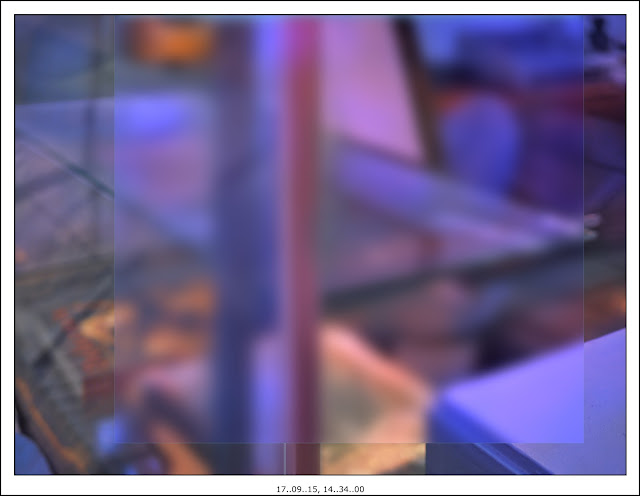Post # 15
Ordered Circumstance,
The reflection of the muse with the placement of thought:
(Cursor on the image for a detailed viewing,
all drawings, Hilde Schreier,
all images copyright Michael Schreier)
Christopher Lea Dunning's work, "Idle in Paris" has encouraged me to revisit George Steiner's two iconic works, Real Presences and After Babel : the latter much more difficult as it has negotiated the complexity of language, semantics and the poetic of significance. In referencing "Babel's fall from grace," Steiner suggests the very basic urgency for voice, thought and continuity as Dunning's inchoate structures and discorded details resonate with appropriate empathy: consider these remarkable short works by
Arnold Schoenberg.
"Idle in Paris"
2008
Painting by Christopher Lea Dunning
I am reminded of Gaston Bachelard's iconic writing The Poetic's of Space, the "room/space" as a support for the silent muse, reverie and the value for passage: incidentally all critical components for one's
Night-Sea Journey. The window, access to the external, social world is gained only through a progressive acknowledgement of "interior" events. While staging at the edge of a theater's proscenium, Dunning asks us to consider a moment of absorbed thought. As beholder, I am made aware of an intimate space and given privileged access to its occupant absorbed in reading: interesting to note a book open on the table, while the other is being read. I am somewhat perplexed whether the book on the table is open to me or whether I am looking at its back. Now, for a moment, consider this self portrait by Austrian painter Carl Moll titled "Self Portrait in Study". In creating a character writing, he implicates the viewer in that moment of theatrical introspection, and privileged intimacy. Although while both artists offer proximity, neither recognize the presence of the beholder. In Dunning's work we are placed as previously indicated, at the edge of the proscenium. Moll offers a distanced staging, complete with curtain, props and a tiled floor describing passage.

Night-Sea Journey. The window, access to the external, social world is gained only through a progressive acknowledgement of "interior" events. While staging at the edge of a theater's proscenium, Dunning asks us to consider a moment of absorbed thought. As beholder, I am made aware of an intimate space and given privileged access to its occupant absorbed in reading: interesting to note a book open on the table, while the other is being read. I am somewhat perplexed whether the book on the table is open to me or whether I am looking at its back. Now, for a moment, consider this self portrait by Austrian painter Carl Moll titled "Self Portrait in Study". In creating a character writing, he implicates the viewer in that moment of theatrical introspection, and privileged intimacy. Although while both artists offer proximity, neither recognize the presence of the beholder. In Dunning's work we are placed as previously indicated, at the edge of the proscenium. Moll offers a distanced staging, complete with curtain, props and a tiled floor describing passage.

The irony for me is that as both artists incorporate portals for transition, Moll suggests a possible entry to a room, Dunning prefers the exact opposite, an exiting. Can it be assumed that the process of reading might involve an exiting while the process of writing implies a moment of entry? Furthermore, intrigued by numerous palimpsests, Dunning makes us aware of the internal structure of the work, perhaps a moment's vulnerability, a disturbance in reading and possible disappearance. He leaves us with the "trace" as a metaphor for vulnerability, and potential loss, the memory of a previous book to be read again. This painting is a profound reflection on passage in which the very structure offers its metaphor.
The book within the book, the event within the event, the painting within the painting, the drawing within its structure are all elements which speak to the very nature of memory, evidence and implied thought.
In "Man With a Movie Camera", Dziga Vertov, (Dziga Vertov, Man with a Movie Camera,circa 1928) defines the relationship between representation, its structure, evidence and allegory, with the quotidian. It is clear that our understanding of structure and method may provide a conviction for truth, as critically as it provides for the mystery of storytelling and abstraction.
2016-2017
From the series Camera Obscura, Stations #2
2016-2017
Michael Schreier
From Series "Stations,#3"
2017,
Finally, as Plato's Cave, an allegory, perhaps instructed to resolve a searching for introspection, inside-out, it also speaks to an artist's deeper moment of clarity, "en atelier" both grounded and without gravity. As Lea Dunning's Idle in Paris might suggest, a moment of "idle" thought embracing all possibility, is it not in that moment of passage, suggested by metaphor and allegory, that representation,( mark-making) occupies time's embrace of change, (frankly, the antithesis of inactivity)? While a composer/film maker (as eloquently described by Sergie Eisenstein in his text Film Form/ Reflections on Sergie Eisenstein) governs the depth and duration of a beholder's experience, the visual artist on the other hand while composing without physical change, must suggest a comparable movement; as an echo becomes stylized, reflective only through evidence of its trace.







